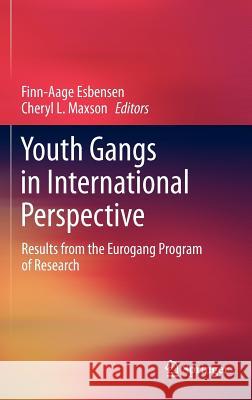Youth Gangs in International Perspective: Results from the Eurogang Program of Research » książka
Youth Gangs in International Perspective: Results from the Eurogang Program of Research
ISBN-13: 9781461416586 / Angielski / Twarda / 2011 / 322 str.
Youth Gangs in International Perspective: Results from the Eurogang Program of Research
ISBN-13: 9781461416586 / Angielski / Twarda / 2011 / 322 str.
(netto: 571,01 VAT: 5%)
Najniższa cena z 30 dni: 562,23 zł
ok. 16-18 dni roboczych.
Darmowa dostawa!
As a steady source of juvenile delinquents and an incubator for future adult offenders, the youth gang has long been a focus of attention, from their origins and prevalence to intervention and prevention strategies. But while delinquent youth form gangs worldwide, youth gang research has generally focused on the U.S.
"Youth Gangs in International Perspective" provides a needed corrective by offering significant studies from across Europe, as well as Trinidad-Tobago and Israel. The book spans the diversity of the field in the cultural and scholarly traditions represented and methods used, analyzing not only the social processes under which gangs operate and cohere, but also the evolution of the research base, starting with the Eurogang Program's definition of the term "youth gang." Cross-national and gender issues are discussed, as are measurement concerns and the possibility that the American conception of the youth gang is impeding European understanding of these groups. Among the topics covered:
Gang dynamics through the lens of social identity theory.Defining gangs in youth correctional settings.Gang gender composition and youth delinquency.From Stockholm: a holistic approach to gang intervention.Gang membership as a turning point in the life course.The impact of globalization, immigration, and social process on neo-Nazi youth gangs.
Filling a critical gap in the literature, "Youth Gangs in International Perspective" will find a wide audience among criminologists, policymakers specializing in youth crime, and researchers and graduate students in criminology, political science, and youth studies.
The topic of youth gangs has received considerable scholarly attention in the United States, and numerous publications have addressed the prevalence of, trends in, and responses to youth gangs. Relatively missing from this field, however, is examination of the youth gang phenomenon outside of the United States. In this volume, youth gang scholars from a variety of countries and disciplines provide unique insights into: 1) definitional and measurement issues; 2) group processes of gangs; and 3) gang research in a number of European countries. §This key work is the fourth such product of the Eurogang Network, a cross-national collaboration of researchers, including top European and American scholars, devoted to comparative and multi-method research on youth gangs and troublesome youth groups. Some of authors are already well-known scholars in the field, while others are breaking new ground in terms of being the first in their countries to raise interest in and conduct research on youth gang issues. Authors come from a variety of scholarly disciplines as well as cultural perspectives, providing rich and diverse views of the youth gang phenomenon. The works presented in the chapters also represent various and rich research traditions, including ethnographic methods, self-report surveys or interviews of youth, surveys or interviews with law enforcement, official records data, and victim interviews. Importantly, and unique in this volume among the few texts that deal with gangs outside the United States all of the contributions utilize the Eurogang Program s definition of youth gang so that, while the groups they describe are located in different countries, comparisons may be drawn between them. The resulting work provides new insights into youth gangs outside the United States, and provides key questions for important future research.











